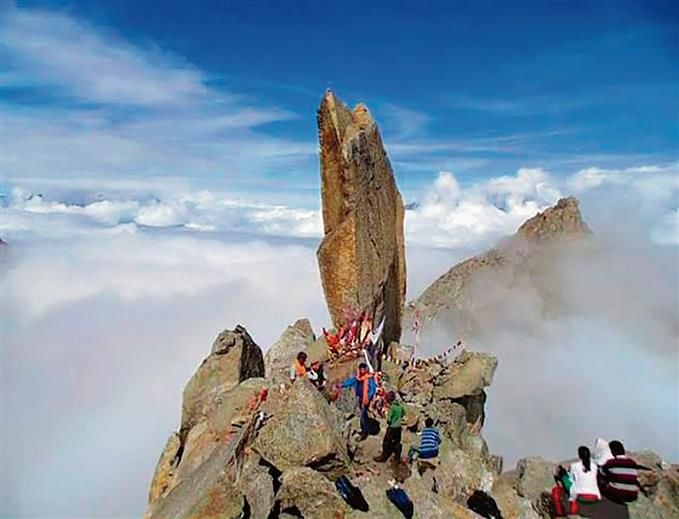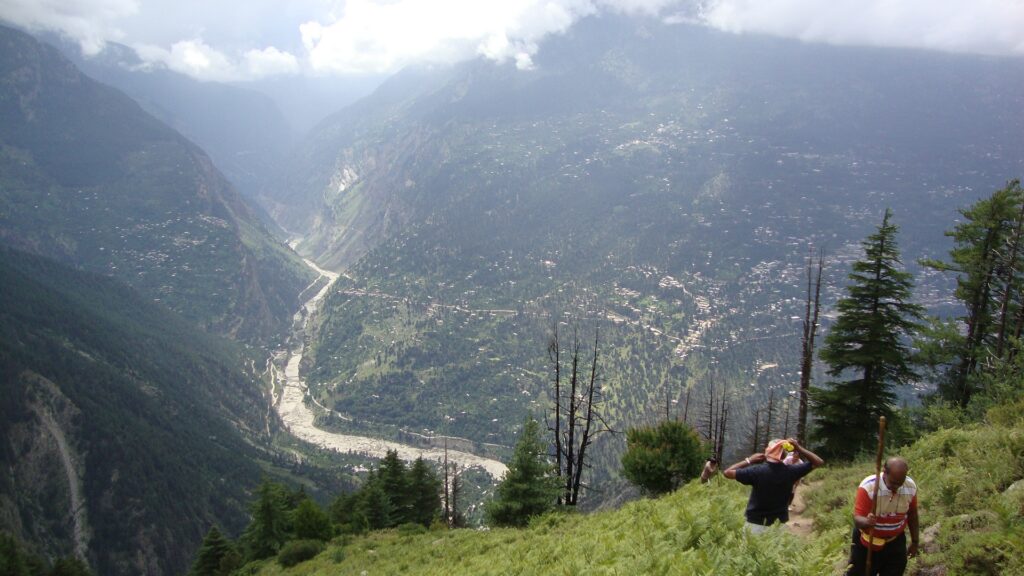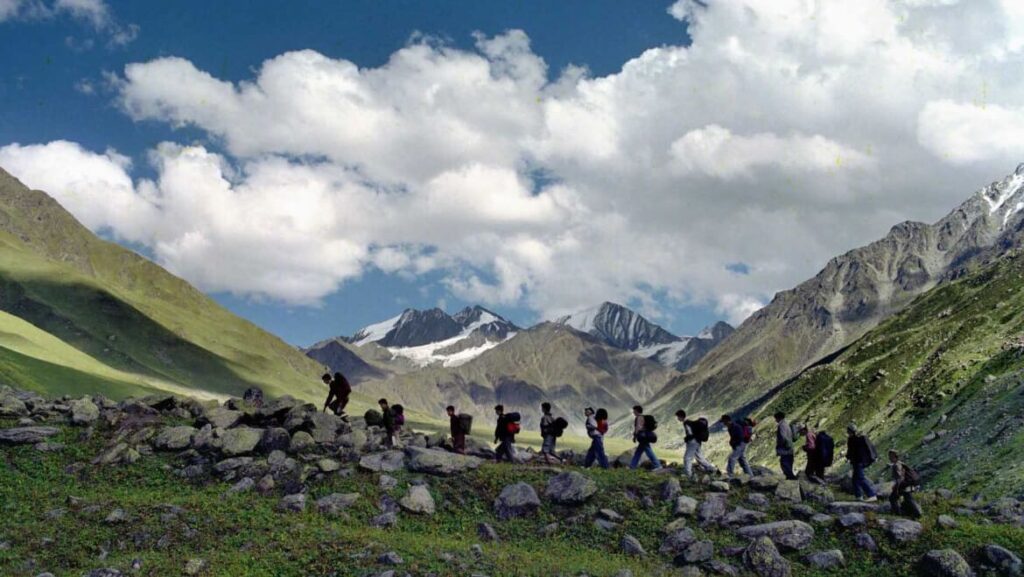Kinnaur Kailash is a mountain in the center of Himachal Pradesh that is respected and resilient. This revered summit of the powerful Himalayas is regarded as the pinnacle of spiritual difficulty and is a real testament to both physical prowess and inner faith. Kinnaur Kailash, which is less well-marketed than Mount Kailash in Tibet but has an equally potent spiritual presence, is a must-see for adventurers and seekers of enlightenment. It is thought to be the winter residence of Lord Shiva.
Reaching Kinnaur Kailash at an elevation of more than 6,000 meters is more than just a hike; it’s a life-changing event. The route puts your endurance to the test while reestablishing your connection to nature and divinity through steep climbs, glacial terrain, and ancient villages. This blog will delve deeply into the geography, history, trek specifics, and tourism insights of the Kinnaur Kailash pilgrimage, a journey that is both empowering and humbling.

Historical and Mythological Importance
Mythology
It is thought that Lord Shiva resides at Kinnaur Kailash. Hindu mythology claims that on this very mountain, Lord Shiva and Goddess Parvati met with local deities. The Shivling rock formation, which undergoes color changes throughout the day, is thought to be a manifestation of God. It is believed that Lord Shiva spends the winter months here, where he meditates alone.
The Kinnaur region is called Kinnaur Desh in the Mahabharata, a mythical place where celestial beings called Kinnaras—part human, part divine musicians—lived. The peak was made even more celestial by the rumor that these creatures lived here and served Lord Shiva.
Cultural Connection
For centuries, the inhabitants of the Kinnaur region have maintained the fusion of Buddhist and Hindu culture. The mountain is never regarded as merely a feature of nature; rather, it is worshipped as a deity. Many Kinnauris participate in seasonal pilgrimages to the mountain base, known as Parikrama of Kinnaur Kailash, and observe spiritual rites.
Terrain and Geographic Location

Location
Kinnaur Kailash is situated close to the Indo-Tibetan border in the northern Indian state of Himachal Pradesh’s Kinnaur district. It is located in the Zanskar sub-range of the larger Himalayan range. Reachable from the town of Reckong Peo, which is the starting point for the trek, the revered peak rises to a height of more than 6,000 meters. The mountain is tucked away among charming villages like Kalpa, Tangling, and Charang, surrounded by thick forests, rocky ridges, and glacial terrains. It is a popular destination for pilgrims and hikers alike because of its remote and untamed setting, which contributes to its spiritual mystique.
Climate and Seasons
Depending on elevation, the area has a subarctic to alpine climate:
- Summer (May to July): With comfortable temperatures ranging from 10°C to 25°C, this season is perfect for trekking.
- Avoidable during the monsoon season (July to September) because of landslides and slick roads.
- Autumn (September to mid-October): Fewer tourists, clear air, and breathtaking views.
- Winter (November to April): Extremely cold and snowy, rendering the area impassable.
Flora and Fauna
The landscape of Kinnaur alternates between arid alpine regions and verdant forests. Higher elevations are home to rhododendrons, alpine shrubs, and wild medicinal herbs, while lower elevations are peppered with deodar, pine, and oak trees. Himalayan ibex, snow leopards, Himalayan blue sheep, and uncommon birds like the monal pheasant are among the fauna.
The Kinnaur Kailash Trek
One of India’s most physically and spiritually taxing treks is the Kinnaur Kailash Trek. It travels through glaciers, high-altitude ridges, and historic villages, fusing natural beauty with mythological significance.

Day 1: Arrival at Reckong Peo (2,290 m)
- Journey to Reckong Peo from Shimla/Chandigarh
- Get supplies and adjust to the new environment.
- optional trip to the Kalpa to see the sunset
Day 2: Drive to Tangling Village – Trek to Malang (3,500 m)
-
Distance: 9–10 km trek
-
Trail: Forested path with apple orchards and streams
-
Night stay in tent
Day 3: Malang to Ashiqui Top (4,700 m)
-
A steep climb with boulder paths and glaciers
-
Ashiqui Top offers surreal views of snow peaks
-
Camp overnight
Day 4: Ashiqui Top to Kinnaur Kailash Shivling (5,200 m) and Return to Ashiqui Top
-
Early morning ascent to the Shivling
-
Offer prayers and soak in the spiritual aura
-
Return to Ashiqui Top for night halt
Day 5–6: Descend via the same route
-
Return to Tangling and then to Reckong Peo
-
Optional village visits in Kalpa and Roghi
Trek Overview
-
Altitude: 5,200 meters (approx. 17,000 feet) at the Shivling base
-
Duration: 6 to 9 days (including acclimatization)
-
Difficulty: Difficult (high-altitude terrain, steep climbs)
-
Best time to trek: May to July and September to October
-
Starting Point: Tangling Village (around 10 km from Reckong Peo)
The Kinnaur Kailash Parikrama
Devotees walk reverently around the mountain’s base on the Parikrama route, which is a more spiritual variation of the trek. It covers the villages of Charang, Chitkul, and Ropa Valley and is distinct from the usual trekking trail. It usually lasts three to four days.
-
Start Point: Charang village
-
End Point: Chitkul (last village before the Tibet border)
-
Distance: Around 60–70 km
-
Difficulty: Moderate to Difficult
Devotees believe completing the Parikrama purifies the soul and earns divine blessings.
Tourism and Infrastructure
How to Reach Kinnaur Kailash
-
By Air: The Nearest airport is Jubbarhatti (Shimla), about 240 km from Reckong Peo.
-
By Train: Nearest railhead is Kalka or Shimla; connect further by road.
-
By Road: Regular HRTC buses and taxis run from Shimla to Reckong Peo.
-
To Trek Base: From Reckong Peo, drive to Tangling village, the starting point of the Kinnaur Kailash trek.
Accommodation
-
Reckong Peo & Kalpa:
-
Budget hotels, guesthouses, and scenic homestays are available.
-
Ideal for acclimatization before the trek.
-
-
Tangling Village (trek base):
-
Limited homestays and basic guesthouses.
-
Pre-arrangement is recommended during peak season.
-
-
On the Trek Route:
-
Tent camping is essential—carry your own or join guided treks.
-
No permanent lodges en route.
-
-
Booking Tip:
-
Book early during summer months (May–July, Sept–Oct).
-
Permits and Fees
- Indian citizens can trek to Kinnaur Kailash without a special permit.
- Due to their proximity to the Tibet border, foreign nationals are required to obtain an Inner Line Permit (ILP).
- Where to Get ILP: Online through the Himachal tourism portal or at the DC Office in Reckong Peo, Shimla.
- Fees: ILP is typically provided without charge or with a small processing fee.
- A valid Indian ID, a passport, or a visa (for foreigners) is a required form of identification.
- It is advised that trekking groups register with the local government.
Cultural and Local Insights
Kinnauri People
The Kinnauri people, who live in the high-altitude valleys of Himachal Pradesh, are hospitable, modest, and profoundly religious. They practice a peaceful fusion of Tibetan Buddhism and Hinduism and are distinguished by their distinctive green woolen caps and traditional dress. Ancient Himalayan culture is reflected in their language, festivals, and customs. Their main sources of income are weaving, agriculture, and apple orchards. The Kinnauri people maintain strong bonds, a wealth of folklore, and a profound respect for the natural world and the gods that protect their sacred territory in spite of their harsh climate.
Cuisine of Kinnaur: A Taste of the Mountains
Kinnaur cuisine is straightforward, filling, and ideal for the chilly mountain climate. A popular dish in the area, siddu is a steamed wheat bread filled with curry or spiced lentils and is frequently eaten with ghee. Tibetan-influenced momos and tukpa are commonly served in local restaurants and homes. Cha, or salted butter tea, is another essential that is well-known for its ability to keep people warm at high elevations.
At festivals and other special events, people drink chhaang, a traditional fermented barley beer. Rice, lentils, seasonal vegetables, and homemade pickles are typically served with meals. Every dish gains nutritional value from the use of organically grown produce and regional herbs. Despite having fewer spices than North Indian food, Kinnauri cuisine provides visitors with a reassuring and spiritual experience.
Festivals
-
Phulaich Festival (September): A flower festival honoring local deities with dances, songs, and sacrifices.
-
Lavi Fair (November): A historic trade fair in Rampur attracting traders from Tibet, Ladakh, and Kinnaur.
-
Losar (February): Tibetan New Year celebrated with rituals, dances, and traditional feasts.
-
Fulaich (Autumn): Marks the return of village deities and communal harmony.
-
Sazo (January): A religious farewell to gods going to the heavens during winter.
-
Baisakhi: Celebrated with joy and traditional dances marking the harvest season.
Environmental Sensitivity and Responsible Tourism
The Kinnaur region’s ecology is delicate. If not handled properly, trekking and tourism can have a negative impact on the environment.
Do’s for Responsible Tourism:
-
Respect Local Culture and Customs: Always ask before photographing locals or religious sites.
-
Carry Reusable Items: Use refillable water bottles, cloth bags, and biodegradable products to reduce plastic waste.
-
Stick to Marked Trails: Avoid making new paths that can damage vegetation and wildlife habitats.
-
Use Eco-Friendly Toiletries: Choose organic soaps and avoid chemical detergents while camping near rivers or lakes.
-
Dispose Waste Properly: Carry trash bags and take your waste back to towns where proper disposal is possible.
-
Support Local Economy: Stay in local homestays, hire local guides, and buy native handicrafts.
-
Travel in Small Groups: Smaller groups cause less environmental strain and are easier to manage in high-altitude zones.
Don’ts for Sustainable Trekking:
-
Do Not Litter: Never leave plastic wrappers, food packets, or bottles behind.
-
Avoid Loud Music and Noise: Disrupting the serene atmosphere can harm wildlife and reduce the spiritual quality of the region.
-
Don’t Pick Plants or Flowers: Many alpine species are rare and some are endangered.
-
Avoid Firewood Collection: Do not cut trees or collect wood; use portable cooking stoves instead.
-
No Graffiti or Rock Markings: Defacing rocks and shrines is disrespectful and illegal.
Tips for Trekkers and Travelers
-
Fitness is key – Start training at least 2–3 months before the trek
-
Hire local guides – They know the terrain, culture, and safety protocols
-
Weather updates – Always check weather forecasts before trekking
-
Mobile networks – Limited to BSNL in high-altitude areas
-
Cash – Carry enough cash as ATMs are rare beyond Reckong Peo
Spiritual vs. Adventurous Experience
Kinnaur Kailash is special because it provides an adventurous expedition in addition to a spiritual journey. This peak has everything you need, whether you want to strengthen your bond with Shiva, push your physical limits, or just take in the serene splendor of the Himalayas.
Kinnaur Kailash, a location where nature and divinity appear to coexist harmoniously, maintains its unadulterated, unadulterated essence in contrast to more commercialized spiritual destinations.
Kinnaur Kailash is a life-changing experience rather than merely a hike or a tourist destination. Trekkers, pilgrims, photographers, and intellectuals are all welcome to explore the sacred paths of this peak, which is known for its ancient myths and high-altitude adventures. We must tread carefully, honor local customs, and protect the mountain’s integrity as tourism gradually increases in this isolated area.
Kinnaur Kailash welcomes you with open arms and snow-covered tranquility if you’re prepared to push yourself, both physically and spiritually.
